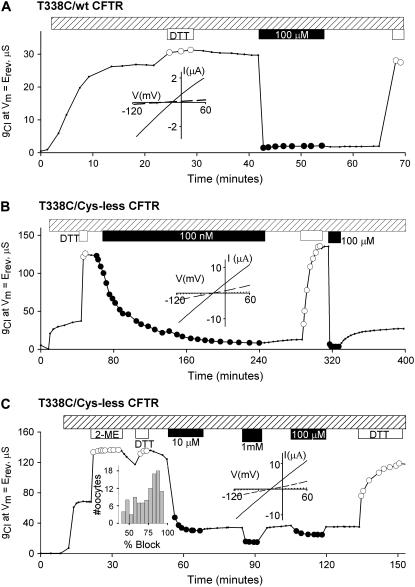FIGURE 2.
[Au(CN)2]− produced a profound, irreversible reduction of gCl in oocytes expressing T338C CFTR. After activation with stimulatory cocktail (hatched bar), oocytes were exposed to 2 ME and/or DTT (1 mM, open circles) and then to [Au(CN)2]− (solid circles). (A) 100 μM [Au(CN)2]− reduced gCl to near background conductance; after [Au(CN)2]− washout the conductance remained at this level. Exposure to DTT reversed the inhibition. (Inset) I/V plot in absence (solid lines) and presence (dashed lines) of 100 μM [Au(CN)2]−. (B) Comparison of two [Au(CN)2]− concentrations; 100 nM [Au(CN)2]− reduced gCl more than 95%. Washout produced a modest rebound of gCl, and DTT (1 mM, open circles) fully reversed the inhibition. Subsequent exposure to 100 μM [Au(CN)2]− provoked a rapid reduction of gCl. Washout resulted in a rebound of ∼20%. (Inset) I/V plot in absence (solid lines) and presence (dashed lines) of 100 nM and 100 μM [Au(CN)2]− (dotted lines). (C) Multiple components of inhibition by [Au(CN)2]−. The oocyte was first exposed to 1 mM 2-ME (open circles) and then to 1 mM DTT (open circles). 10 μM [Au(CN)2]− produced a rapid and largely irreversible reduction of gCl by ∼70%. Subsequent exposure to 1 mM and 100 μM [Au(CN)2]− produced additional dose-dependent, reversible block. (Inset) I/V plot in absence (solid lines) and presence (dashed lines) of 10 μM and 1 mM [Au(CN)2]− (dotted lines). Histogram represents percentage of conductance block calculated in oocytes after exposure to 100 μM [Au(CN)2]−.

